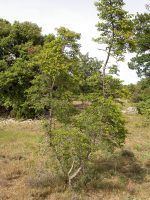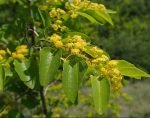 Also known as Jerusalem thorn, garland thorn, or crown of thorns, this deciduous shrub or small tree is native to the Mediterranean region and southwest and central Asia. It is a member of the hawthorn family, Rhamnaceae, that also inclues California lilac and jujube tree. The straggly plants grow 16-20′ tall and have zigzag pliable branches bearing ovate to round, leathery, glossy green leaves 3/4-1″ long. Each leaf is finely toothed and has a straight and a curved stipular spines on the outside of each twist. From July to August clusters of small greenish flowers appear and are followed by leathery, brownish yellow nutlets surrounded by a circular wing about 1″ across. Christ’s thorn is sometimes used as a hedge. The branches may have been used to make the crown of thorns placed on Christ’s head before the crucifixion but Ziziphus spina-christi (Christ’s thorn jujube) has also been suggested. The genus name, Paliurus, is the ancient Greek name for this species. The specific epithet, spina-christi, are the Latin words meaning thorns of Christ and refer to its supposed use at the crucifixion. Photo Credit Fritz Geller Grim Wikipedia
Also known as Jerusalem thorn, garland thorn, or crown of thorns, this deciduous shrub or small tree is native to the Mediterranean region and southwest and central Asia. It is a member of the hawthorn family, Rhamnaceae, that also inclues California lilac and jujube tree. The straggly plants grow 16-20′ tall and have zigzag pliable branches bearing ovate to round, leathery, glossy green leaves 3/4-1″ long. Each leaf is finely toothed and has a straight and a curved stipular spines on the outside of each twist. From July to August clusters of small greenish flowers appear and are followed by leathery, brownish yellow nutlets surrounded by a circular wing about 1″ across. Christ’s thorn is sometimes used as a hedge. The branches may have been used to make the crown of thorns placed on Christ’s head before the crucifixion but Ziziphus spina-christi (Christ’s thorn jujube) has also been suggested. The genus name, Paliurus, is the ancient Greek name for this species. The specific epithet, spina-christi, are the Latin words meaning thorns of Christ and refer to its supposed use at the crucifixion. Photo Credit Fritz Geller Grim Wikipedia
 Type: Deciduous shrub or small tree
Type: Deciduous shrub or small tree
Outstanding Feature: Possible biblical crown of thorns
Form: Vase-shaped; straggly
Growth Rate: Slow to moderate
Bloom: Clusters of greenish small greenish yellow flowers from July to August
Size: 16-20′ H x 16-20′ W
Light: Full sun to light shade
Soil: Average, dry to medium moist, well-drained; tolerates drought and very alkaline conditions.
Hardiness: Zones 7-10
Care: Plants regrow from the base if cut back.
Pests and Diseases: Not available; resistant to honey fungus
Propagation: Seed, semi-ripe cuttings in summer, root cuttings in winter, layering
Outstanding Selections: None
Photo Credit: Photo Credit Fritz Geller Grim Wikipedia